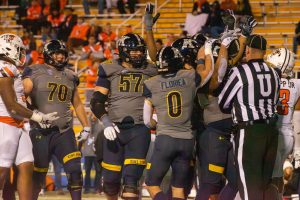Kent State shines ‘Spotlight’ on ethics
Matt Carroll, former reporter for the Boston Globe and member of the Spotlight team, Kim Garchar, associate professor of philosophy, Jim Crutchfield, former president and publisher of the Akron Beacon Journal, and Thor Wasbotten, direction of the School of Journalism and Mass Communication answer questions as apart of a panel discussing ethics of investigative journalism after screening the film “Spotlight” during their “Media at the Movies” event on Tuesday, March 7, 2017.
March 7, 2017
The School of Journalism and Mass Communication (JMC) hosted its third annual Media at the Movies night in Franklin Hall on Tuesday.
During the event, students and faculty viewed the movie “Spotlight” and discussed the ethics of journalists in a panel after the movie.
“Spotlight” focuses on a group of reporters at The Boston Globe who, in 2002, uncovered years of sexual abuse in the Catholic Church. The movie prompted the panel to discuss journalist’s responsibilities to victims and how to make tough time-sensitive decisions.
Matt Carroll, the data expert on the Spotlight team at The Boston Globe during the investigation, joined the discussion via Skype. He offered input using his firsthand experience of working closely with this story.
“I had a lot more empathy for people after (the investigation),” Carroll said. “You have no idea what goes on in people’s lives.”
The panel also included Jim Crutchfield, a former president and retired publisher of the Akron Beacon Journal; Kim Garchar, associate professor of philosophy at Kent State University; and Thor Wasbotten, director of JMC. Jan Leach, associate professor and director of the Media Law Center, moderated the speech.
“When we (the panel) talk to you about journalism ethics, it’s about asking the really tough questions and then asking them again,” Wasbotten said.
Students filled First Energy auditorium in Franklin Hall and asked Carroll questions about his time with the investigation.
Senior communication studies major Braylon Lee asked, “How do you deal with the aftermath of telling stories and how do you help the community afterwards?”
Carroll explained that since the 2002 investigation, “news organizations are rethinking their engagement and ties with the community.”
Garchar said when communities have strong ties to organizations or an institution, such as the Catholic Church, it is harder to restore an image of purity after traumatic events.
“We have to think beyond breaking the story,” Garchar said. “Breaking the story is meant to shock and disrupt. Once you disrupt what do you do to rebuild?”
Carrie Buchanan, assistant professor of communication and theatre arts at John Carroll University, responded to a question about a journalist’s responsibility to inform the public when someone has done something bad.
She finds the solution in understanding the impact of what that person did.
“That’s why they (Spotlight) talked to 600 victims,” Buchanan said. “It’s the impact.”
She also called upon journalists to recognize their moral responsibility that comes along with the job.
“If we don’t look at ourselves and keep ourselves transparent,” Buchanan said. “We have no right to call out anyone else for being unethical.”
Wasbotten made sure to connect all students in the audience, regardless of major, to this movie so they could think ethically on issues that they will encounter.
“Journalists need you to make sure journalism stays alive,” Wasbotten said.
Molly Spillman is the CCI reporter, contact her at [email protected].















